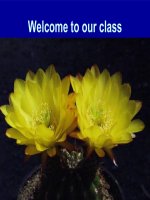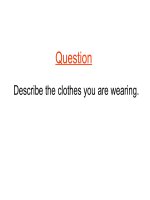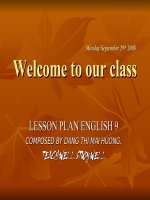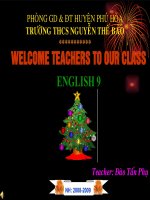Unit 2 Clothing
Bạn đang xem bản rút gọn của tài liệu. Xem và tải ngay bản đầy đủ của tài liệu tại đây (271.92 KB, 28 trang )
<span class='text_page_counter'>(1)</span>CLOTHING. UNIT 2 DIVISION OF THE LESSONS _ Period 7 Lesson 1 Getting Started – Listen and Read _ Period 8 Lesson 2 Speak + Listen _ Period 9 Lesson 3 Read _ Period 10 Lesson 4 Write _ Period 11 Lesson 5 Language focus _ Period 12 Consolidation for 45 minutes test ________________________________________________________ Week: 4. UNIT 2. CLOTHING. Period:7 Lesson 1: GETTING STARTED – LISTEN and READ Date:19.9.2016 I > AIMS: _ By the end of the lesson , Ss will be able to know about the traditional customes of some countries and the Ao dai in Vietnam. _ Ss should be taught to wear Ao dai on the occasions because it is the traditional long dress of Vietnamese women. II > LANGUAGE CONTENTS: 1, Grammar: 2, Vocabulary: clothing, fashion designer, fashionable, long silk, tunic, loose pant, inspiration , ethnic minorities. III > TECHNIQUES: Cross word, Picture drill, Pair work / Group work IV > TEACHING AIDS: Tape, Cassette, Pictures about Ao dai V > PROCEDURES: TEACHER’S and Ss’ ACTIVITIES _ Greeting _ Checking attendance. _ Teacher has Ss to play “ Cross word” . _ Teacher gives Ss some information. + Ss guess the word and write it in the box. _ If Ss find 8 correct words , they will have a tittle word of the letter. + Ss give the correct words. _ Teacher corrects and gives Ss the answer key and the key word.. CONTENT 9A1:………………………………………… 9A2:………………………………………… 9A3:………………………………………… 9A4:………………………………………… 1 . Warm up ( 7 minutes) CROSS WORD 1, The country whose capital is Phnom Penh. 2, A friend who keeps in touch through letter. 3, The place where we go to study. 4, The past form of “ TAKE”. 5, The country has a largest population in the world. 6, The city named” The windy city” in USA. 7, The money system is used in a country. 8, It is the belief in superhuman especially in Gods..
<span class='text_page_counter'>(2)</span> Key: 1CAMBODIA 2PENPAL 3 S C HO O L 4TOOK 5C H I N A 6CH I CAGO 7CURRENCY 8RELIGION Key word: CLOTHING _ Teacher introduces to Ss the lesson. 2 . Presentation ( 15 minutes) + Ss listen carefully. Today we will learn about the traditional ( This is a difficult activity, so Teacher should ask Ss customes of some countries.First you look at the to work in groups). address that some people are wearing .Dicide _ Call representative of each group to give the ideas. where each person comes from. _ Teacher corrects and gives Ss the correct answer.( The picture , page 13) _ Teacher can express the traditional dress of each Key: picture if possible. a. She is from Japan.She is wearing a Kimono. b. She Vietnam Ao dai c. He Scotland a Kilt d. She India a Sari e. He USA a cow boy f. She Arabia a Weil _ Teacher hangs a picture about “ A woman is As we know , Ao dai is the traditional customes wearing Ao dai” and asks Ss “ What is she of Vietnamese people. wearing? “ _ What do you know about Ao dai? + Ss answer:” She is wearing Ao dai.” _ What material is Ao dai made from? _ Teacher introduces to Ss the lesson. Vocabs: _ Teacher asks Ss 2 questions _ poet (n) nhaø thô + Ss answer the questions. _ musican (n) nhaïc só _ Teacher uses a pictures about Aodai to _ long silk tunic(n) aùo luïa daøi explain some new words. _ loose pant(n) quaàn roäng + Ss look at the picture and guess the meaning. _ ethnic minoraties(n) daân toäc thieåu soá _ Teacher guides Ss to read Vocabs. _ traditional design(n) thieát keá truyeàn thoáng + Ss read Vocabs ( Choral – Indiv ) _ fashionable (a) hợp thời trang _ Teacher corrects Ss’ pronunciation. _ inspiration(n) cảm hứng _ Teacher gives Ss a question Question: + Ss listen and answer the question. Is modern Ao dai different from the old one? _ Teacher plays the tape once . + Ss listen and answer the question _ Teacher corrects Ss’ mistakes. 3. Practice ( 15 minutes) _ Teacher has Ss read the text in silence .Find Modern Ao dai is different from the old one..
<span class='text_page_counter'>(3)</span> the information in the text to complete the sentences. + Ss read the text and do exercise. _ Call Ss to give the answer on the board. _ Teacher corrects Ss’ mistakes and gives Ss the correct answer.. _ Teacher guides Ss “ Now you read the text again and answer the questions in (b). + Ss read the text again, practice in pairs .Then compare the answer with partners. _ Teacher calls Ss to practice in front of class. Then write the answers on the board. _ Teacher corrects and give Ss the correct answer. + Ss observe and write the answer in their book. _ Teacher has Ss read the text loudly in front of class. _ Teacher corrects Ss’ mistakes pronunciation. _ Teacher has Ss discuss in groups and answer the question.. . a/ Complete the sentences. Key: 1, …………………… poems, novels, and songs. 2, ………………….. long silk tunic with slits up the sides worn by over loose pants. 3, ………………….. to wear modern clothing at work . 4, ………………….. lines of poetry unit. 5, ………………….. symbols such as suns, stars, crosses, and stripes. b/ Answer the question. Answer: 1. Traditional men and women used to wear the Ao dai . 2. Because it is more convenient. 3. They’re printed lines of poetry on it or have added symbols such as stars, suns, crosses and stripes to the Aodai.. 4 . Production( 5 minutes) What color is popular with ao dai ? With students at high school ? With the middle aged…………….. ? 5. Home work ( 3 minutes) _ Read the text at home. _ Learn Vocabs by heart. _ Prepare: UNIT 2 CLOTHING Lesson 2 : SPEAK - LISTEN + Vocabs about clothing: a colorful T-shirt , a plaid skirt, a plain suit, a short sleeved blouse, a sleeveless sweater , a striped shirt, baggy pants, faded jeans , blue shorts.. COMMENTS:. + Advantages :.......................................................................................................................... .................................................................................................................................................... + Disadvantages: ...................................................................................................................... .................................................................................................................................................... + Solutions:.................................................................................................................................
<span class='text_page_counter'>(4)</span> ................................................................................................................................................... Week: 4 Period : 8 Date: 19.9.2016. UNIT 2. CLOTHING. Lesson 2 : SPEAK-LISTEN. I > AIMS: _ By the end of the lesson , Ss will be able to ask and respond to questions on personal references; listen for specific information about clothing, describe what people are wearing. II > LANGUAGE CONTENTS: 1, Grammar: _ What do you usually wear on the weekend? _ Why do you wear these clothes? _ What is your favorite type of clothing? Why? _ Is it comfortable? _ What color is it? 2, Vocabulary: a colorful T-shirt , a plaid skirt, a plain suit, a short sleeved blouse, a sleeveless sweater , a striped shirt, baggy pants, fadded jeans , blue shorts III > TECHNIQUES: Word square, IV > TEACHING AIDS: Tape, cassette V > PROCEDURES: TEACHER’S and Ss’ ACTIVITIES _ Greeting _ Checking attendance. _ Teacher sticks the poster on the board. _ Ask Ss to find 8 nouns and 4 adjectives about clothing in the word square. _ Divide the class into 2 teams , Ss of each team go to the board and circle the words they have found then write them down in the column of their team. _ The team which has more words will win the game.. CONTENT 9A1………………………………………… 9A2………………………………………… 9A3………………………………………… 9A4………………………………………… 1 . Warm up ( 5 minutes). WORD SQUARE A C P L A I D T F. T R I H S A H S I. P G O U H E M T W. L H I U S H O R T. A T K E W I B I J. I Z O J E N A P E. N L Y R A G G E A. B P A N T S G D N. D W M V E J Y J S. F Q X L R S L O T.
<span class='text_page_counter'>(5)</span> U. K. B. S. K. I. R. T. B. E. Answer: sweater, jeans, skirt, striped, baggy, plain suit blouse plaid, shorts, pants, shirt _ Teacher introduces to Ss the situation of the 2 . Pre ( 13minutes) lesson. In the last lesson , we got some information _ Teacher hangs 9 pictures about clothing on the about Ao dai , the traditional dress of board. Vietnam. Today we’ll learn about the casual clothes that _ Teacher asks Ss to look at the pictures and we wear daily. match them with the phrases. Answer: + Ss look at and do exercise. a. a colorful T-shirt: Aùo phoâng nhieàu maøu _ Teacher calls Ss to give the anser on the b. a sleeveless sweater: Aùo len coäc tay board. c. striped shirt: Aùo sô mi keû soïc _ Teacher guides Ss to read these words and d. a plain suit: Boä quaàn aùo comple asks Ss the meaning of these words. e. faded jeans:quaàn boø maøi _ Teacher calls Ss to read these words. f. a short sleeved blouse: aùo sô mi ngaén tay + Ss read in chorally- individually. g. baggy pants: quaàn thuïng h. a plaid skirt: vaùy keû oâ i. blue shorts.: quaàn soùoc xanh Checking the vocabulary: * Review the vocabularies: : - What do you call these clothes in English ? - T. asks Ss to identify the pictures by asking - What kind of blouse is this ? them some questions like these: - Are these shoes or sandals ? KEY: a). A. baggy pants B. blue shorts C. a pink skirt - Ss call those things in English: b). A. a long - sleeved white blouse. B. a short – sleeved pink blouse. C. a. short – sleeved white blouse. c) A. blue sandals B. red boots - T. sets the scene: C. brown shoes ---> You will hear an announcement about a lost little girl called Mary, listen and choose the correct pictures to show what is Mary wearing. - Ss predict the clothes Mary wore. ( Ss’ prediction) 3 . While ( 19 minutes) 3.1 Speaking .
<span class='text_page_counter'>(6)</span> _ Ask Ss to remember the phrases on page 14,15 in 30 seconds. Then let their book closed. _ Divide class into 4 groups. _ Students from each group take turn to go to the board write as many words as they can. _ Group with the most words wins the game. Teacher guides Ss “ Now you work in small groups and look at the survey about Ss’ wear: casual clothes, favorite clothes, clothes for sopecial occasions,.First you discuss and write two more questions for the section of the survey. _ Teacher can provide some questions for interview. _ Ask Ss to interview their friends. _ Ask Ss to report the result of their survey in their group. The survey should begin as follow: _ Call the representative from each group to present the result of the survey in front of class. _ Teacher asks Ss to do exercise. + Ss put the clothes in the right sections. _ Teacher corrects Ss’ answer.. - Teacher gives sts some tasks to do at home.. . Casual clothes: _ What do you usually wearv on the weekend? _ What do you wear these clothes? Favorite clothes: _ What is your favorite clothes? Why? School uniform: _ Is it comfortable? _ What color is it? Clothes for special occasions: _ What type of clothing do you wear on Tet holiday? _ What do you wear when you go to the party? c/ _ Three people said that they liked their uniform. _ Two people siad that they usually wore colorful T-shirt on the weekend. _ Chi said she loved baggy pants. 3.2. Listening Key: a) B. blue shorts. b) A. a long – sleeved white blouse. c) C. brown shoes. 4 . Post ( 5minutes) Put the clothes in the right sections a blouse a tie shoes a shirt a boot a dress a skirt sandals swimming trunk 1. Women’s clothes: a blouse, adress . a skirt 2. Men’s wear: a shirt , a tie, swimming trunk 3. Foot wear: sandals, boots, shoes 5. Home work ( 3 minutes) _ Learn by heart ll the words about clothing. _ Make the list of types of clothing that most of the students in the class like wearing on different speciasl cases. _ Prepare: UNIT 2: CLOTHING Lesson3: READ (New words Exercise a+b /page 17, 18/ SB).. COMMENTS:. + Advantages :.......................................................................................................................... .................................................................................................................................................... .................................................................................................................................................... + Disadvantages: ...................................................................................................................... .....................................................................................................................................................
<span class='text_page_counter'>(7)</span> .................................................................................................................................................... + Solutions:................................................................................................................................ ................................................................................................................................................... .................................................................................................................................................... ..................................................................................................................................................... Week:5. UNIT 2. Period: 9 Date: 21.9.2015. CLOTHING. Lesson 3:. READ. I > AIMS: _ By the end of the lesson , Ss will be able to understand the text for details, about jeans. _ Ss should be taught to wear jeans on special occasions such as Tet, holidays, on the weekend, but not at school. II > LANGUAGE CONTENTS: 1, Grammar: 2, Vocabulary: material, cotton, wear out, style, embroider, label III > TECHNIQUES: Net work, What and Where, Brainstorming IV > TEACHING AIDS: Text book, Picture about jeans. V > PROCEDURES: TEACHER’S and Ss’ ACTIVITIES _ Greeting _ Checking attendance. - T. points to the picture and ask the Ss. - Ss answer: - T. introduces the text.. - Ss. listen to the tape (once) - T. presents the vocabulary.. - Ss read the new words (chorally, individually). CONTENT 9A 1:………………………………………… 9A 2:………………………………………… 9A 3:………………………………………… 9A 4:………………………………………… 9A5:………………………………………… 9A6:………………………………………… 1. Warm up ( 5minutes) - What are the students wearing ? --> They are wearing jeans. - Today, we’ll learn about the text of jeans – the history of development of jeans. 2. Pre - Reading ( 10 minutes) * Listening: (The text on page 17 / SB). * New words: (N) :- material - Europe - sailor - jean cloth - cotton - style.
<span class='text_page_counter'>(8)</span> -T. gives Ss three pre -questions.. - Ss listen to the tape and look at their books. - Ss read the text in silence, then read aloud (paragraph by paragraph). - Ss answer the pre- questions:. - label - sale - economic situation - generation. (V) - embroider - wear out - (be) out of fashion. (Adj) - embroidered. 3. While – Reading (20 minutes) * Pre - questions: 1- Where does the word jeans come from ? 2- Who wore jeans at first ? Why ? 3- Who wear jeans today ? * Listen and read:. (The text on page 17 / SB).. KEY : 1- The word jeans comes from a kind of material that was made in Europe. 2- The sailors and workers wore jeans at first because the material was very strong and it did not - Ss do exercises a, b /p. 17 +18 wear out easily. (work in groups). 3- Young generation wear jeans today. * Exercise a: Fill in the missing dates and words KEY: 1. 18th century : Workers like to wear jean cloth because the material made from cotton very strong and could hardly wear out. 2. 1960s : A lot of university and college students wore jeans. - The other students comment and the teacher 3. 1970s: Jeans became cheaper so many, many corrects Ss’ mistakes. people began wearing jeans. 4. 1980s: Jeans became high fashion clothing. 5. 1990s: The sale of jeans stopped going up. * Exercise b: Answer the questions KEY: 2. The 1960s’ fashion were embroidered jeans, painted jeans and so on. 3. Because jeans became cheaper..
<span class='text_page_counter'>(9)</span> - Ss practice speaking - T. gives Ss assignment. 4. Jeans at last became high fashion clothing in the 1980s. 5. Because in the 1990s , the worldwide economic situation got worse. 4. Post – Reading ( 5 minutes) ( Suggested dialogue) A : Do you like wearing jeans ? Why ? / Why not ? B:…………………………………………………………………………………………… A: What type of jeans do you like wearing ? B:………………………………………………………………………………………… A: Do you think jeans are still fashion now ? B: …………………………………………………………………………………….. 5. Homework ( 5 minutes) - Learn the new words by heart. - Reread the text, the questions and answers. - Do exercise 4 / p. 15+16 / WB. - Prepare WRITE (new words, posters). COMMENTS: + Öu ñieåm :................................................................................................................................ .................................................................................................................................................... .................................................................................................................................................... .................................................................................................................................................... + Toàn taïi: .................................................................................................................................. .................................................................................................................................................... .................................................................................................................................................... .................................................................................................................................................... + Hướng khắc phục:................................................................................................................. .................................................................................................................................................... .................................................................................................................................................... .................................................................................................................................................... .....................................................................................................................................................
<span class='text_page_counter'>(10)</span> Week : 5. UNIT 2. CLOTHING. Period:10 Lesson 4 : WRITE Date : 21.9.2015 I > AIMS: _ By the end of the lesson , Ss will be able to write an exposition , presenting one side of an argument. II > LANGUAGE CONTENTS: 1, Grammar: _ My opinion is………………….. I think……………………………… _ Firstly………. Secondly Thirdly Finally _ Therefore _ Inclusion 2, Vocabulary: encourage, be equal in , bear one’s name, freedom of choice, self- confident III > TECHNIQUES: Chatting, Rub out and Remember IV > TEACHING AIDS: V > PROCEDURES: TEACHER’S and Ss’ ACTIVITIES _ Greeting _ Checking attendance. _ Teacher asks Ss some questions about their feeling when wearing different types of clothing. + Ss answer the questions. _ Techer corrects Ss’ mistakes.. _ Teacher presents to Ss some Vocabs by. . CONTENT 9A1:………………………………………… 9A2:……………………………………….. 9A3:………………………………………… 9A4:……………………………………….. 9A5:………………………………………… 9A6:…………………………………………. 1 > Warm up ( 5 minutes) CHATTING _ How often do you wear uniforms? _ How do you feel when wearing uniforms? _ If you have a choice , what type of clothing.
<span class='text_page_counter'>(11)</span> some techniques. + Ss observe and guess the meanings of these words. _ Teacher guides Ss to read these words. _ Teacher calls Ss to read these words. ( Chorally- Individually) _ Teacher corrects Ss’ mistakes in pronuncition. _ Teacher uses “Rub out and Remember” to check Ss’ vocabs. _ Teacher rubs out a word in English and points to Vietnamese translation and asks “ What’s this in English?”. When all the English words are rubbed out , go through the Vietnamese list and gets the sts to come to the board and write the English words again. _ Teacher sticks or draws the following table on the board. _ Tell the sts it is the outline to present one side of an argument. _Give out to the sts sets of different color strips of paper, on which the content of the outline written as follow: Letsisthe readers know the writer’s point of view Present arguments in a logical way ( one in each paragraph) Give examples where possible Sum up the argument My opinion is………………………………………………. _ Ask ss to go to the board , stick the strips on I think……………………………………………………………… the Firstly……………………………………………………………… correct space. _ They can do this task as a game. Group Secondly……………………………………………………….. which has more strips filling in the table with Finally……………………………………………………………. correct content is the winner. Therefore………………………………………………………. _ Ask Ss to answer the questions to check In conclusion……………………………………………………. their understanding. _ Ask Ss to read the topic and the Outline A. _ Ask Ss some comprehension questions.. do you want to wear when going to school ? Why do you choose it? 2 > Pre-Writing ( 17 minutes) Pre- teach vocabulary: _( to) encourage ( explanation: to give hope , support or confidence to sbd) động viên , khuyeán khích _ (to) be equal in ( explanation: + Ba is 32 kg in weight, Tan is 32 kg, too. They are equal in weight.) coâng baèng , baèng nhau. _(to) bear one’s name( picture) mang teân _ freedom of choice(translation) tự do lựa chọn _ self-confident (translation) tự tin Checking Vocabulary: Rub out and Remember. + What do you write in “ Introduction”? What language is used? +How can we present series of arguments? What language is used? + What do you write in “ Conclusion” ? What language is used? + What is the topic of the passage? + Why does wearing uniforms encourage Ss to be pruod of their school? 3 > While-Writing ( 15 minutes) ( Because the uniforms bear their school’s name.) + How do sts feel when wearing uniforms? ( They feel equal in many ways) + Do Ss have to think of what to wear everyday? (No) + How is the argument organized?.
<span class='text_page_counter'>(12)</span> _ Ask sts to read the passage to answer the questions. _ Ask sts to read the Outline B and anser the question.. _ Tell sts to work in groups to discuss and get some more ideas about the topic. _ Ask sts on their own to write a paragraph of 100-150 words to support the argument that secondary school sts should wear casual clothes , using the Outline on page 19.. _ When sts have finished writing , let them compare their writing and correct mistakes. _ Take some writings to correct in front of class. _ Teacher gives sts some tasks to do at home.. + What is the topic of the argument? + Why should secondary sts wear casual clothes? ( wearing uniforms makes sts feel comfortable , give them freedom of choice , make sts feel confident , makes school more colorful and lively) Suggested writing: In my opinion , secondary sts should wear casual clothes. _ Firstly, casual clothes make sts feel comfortable. _ Secondly, wearing casual clothes gives sts freedom of choice. They have right to choose sizes, colors and fashion that they love. _ Thirdly, casual clothes makes sts feel self confident when they are in their favorite clothes. _ Finally, casual clothes makes school more colorful and lively. _ In conclusion, secondary school sts should wear casual clothes . Wearing casual clothes is convenient , comfortable and fun. 4 > Post-Writing:( 5 minutes) Correction the writing 5 > Home work ( 3 minutes) _ Learn the Outline of the argument. _ Write the passage in the notebook. _ Prepare: UNIT 2 CLOTHING Lesson 6: LANGUAGE FOCUS. + Review the present perfect with already, yet, ever, never. + Review the passive forms of present perfect ,simple present , simple past, and simple future. + The passive forms of modal verbs : have to , be going to………………... COMMENTS: + Öu ñieåm :................................................................................................................................ + Toàn taïi: .................................................................................................................................. .................................................................................................................................................... .................................................................................................................................................... Week :6. UNIT 2. CLOTHING.
<span class='text_page_counter'>(13)</span> Period:11 Lesson 5: LANGUAGE FOCUS Date : 3/10/2016 I > AIMS: _ By the end of the lesson , Ss will be able to use already and yet in the present perfect tense , distinguish the difference between the past simple and present perfect tense, and be able to use the passive form of the present perfect , simple present , simple past and simple future ; practice passive modal auxiliaries. II > LANGUAGE CONTENTS: 1, Grammar: _ The present perfect with already, yet, ever, never. _ The passive forms of present perfect , simple present , simple past, and simple future. _ The passive forms of modal verbs : have to , be going to ……………….. 2, Vocabulary: III > TECHNIQUES: Pelmanism IV > TEACHING AIDS: V > PROCEDURES TEACHER’S and Ss’ ACTIVITIES _ Greeting _ Checking attendance. _ Teacher prepare 10 cards with numbers from 1 to 10 on one side and the verbs on the other. _ Stick the cards on the board so that the sts can only see the numbers , make sure the verbs are mixed up. _ Divide class into 2 teams .Each team chooses two numbers. _ Turn the cards over if they match : Ex: run - ran ; that team gets one mark. _ If not , turn the cards over again and ask the next team to continue. _ Go on until all the cards are turned over. The team which has more marks will win the game. _ Ask sts to look at the dialogue on page 19. _ Elicit from students. - Teacher reviews sts the present perfect tense with some adverbs of time.. CONTENT 9A1:………………………………………… 9A2:………………………………………… 9A3:………………………………………… 9A4:………………………………………… 1 > Warm up:( 5 minutes) Pelmanism do. visited. went. go. saw. eat. 2. Presentation: ( 15 minutes) 2.1 The present perfect _ The present perfect tense is used to talk about sth which started in the past and continues up to the present. _ FOR + period of time Ex: for 2 years.
<span class='text_page_counter'>(14)</span> - Teacher reviews sts the passive voice. _ Teacher asks sts to use the information in the table on page 20 to make similar dialogues. Then practice with their partners. + Sts practice in pairs. _ Tell sts they can also ask each other about themselves on this topic. _ Teacher goes around class, taking notes in order to help correct Ss’ pronunciation, intonation, past participle of irregular verbs.. _ Teacher asks sts to practice the dialogue in pairs. _ Teacher goes around class, taking notes mistakes sts have made for the delayed. SINCE + a point of time Ex: since 1980 We often use for and since with the present perfect tense. ALREADY is used in affirmative sentences. Position: midsentence YET is used in the negative sentence and questions. Position: end of the sentence. EVER: is used in questions. Meaning: có bao giờ 2.2 The passive A, Review the passive forms of present perfect , simple present , simple past, and simple future. _ Simple present: S+ am/ is / are + V ( v3/ ed). _ Simple past: S+ was / were + V( v3/ ed) _ Present perfect: S+ have / has + been + V( v3 / ed) ….. _ Simple future: S+ will / shall + be + V ( v3 / ed) Ex: They sell jeans all over the world. Jeans are sold all over the world. B, The passive forms of modal verbs and the verbs patterns : have to , be going to _ Form: modal verbs + be + past participle have to / be going to + be+ past participle Ex: You must do this exercise carefully. This exercise must be done carefully. 3. Practice ( 17 minutes) Suggested dialogues: b/ A: Come and see my photo album. B: Lovely! Who’s this boy? A: Ah! It’s Quang, my brother’s friend. B: How long have you known him? A: I’ve known him for seven months B: Have you seen him recently? A: No, I haven’t seen him since January. He has ( + V-ed). 3 > Activity 2 I have seen Giac Lam Pagoda. I have eaten Chinese and French food. I haven’t seen Unification Palace , Zoo and Botanical garden , I haven’t tried Vietnam.
<span class='text_page_counter'>(15)</span> correction. _ Teacher sets the scene: “ Tom and Mary are talking to each other about places they have been to”. _ Ask sts to look at the dialogue.. vegetarian. A: Have you seen the Giac Lam Pagoda yet? B: Yes, I’ve already seen it. A: Have you eaten Vietnamese food yet? B: No, I haven’t. Examples: A: Have you seen the Reunification Palace yet? B: No, I haven’t. A: Have you tried French food? B: No, I haven’t. B, Review the present perfect with EVER. Elicit from the students. + We use the past simple to talk about definite time. Ex: I went to France last year / two months ago / in 1992. + We use the present perfect to talk about indefinite past time. Ex: Have you ever ( at some time in your life) been to Italy? _ Run through the Vocabs in exercise 3 on page 20. Read a comic Use a computer Go to the market Play volleyball Go to Singapore Go to the movies See an elephant Eat durian Example: A: Have you ever read a comic? B: Yes, I have. A: When did you last read one? B: This morning. 4 > Activity 3 : Answers: _ Ask sts to do the exercise. a/ Jeans cloth was made completely from cotton in _ Teacher goes around class, taking notes the 18th century. mistakes and correct. b/ Rice is grown in tropical countries. _ Teacher gives sts the correct answer. c/ Five million bottles of champagne will be _ Teacher introduces to sts the passive forms of produced in France next year. modal verbs and the verbs patterns : have to , be d/ A new style of jeans has just been introduced in going to the USA. _ Elicit from sts the modal verbs : must, can , e/ Two departments stores have been built this should, might, and the verbs patterns : have to , year. be going to Answers: _ Teacher asks sts to do exercise 5 on page 21. a) The problem can be solved . _ Teacher goes around class, taking notes b) Experiment on animals should be stopped..
<span class='text_page_counter'>(16)</span> mistakes and correct. _ Teacher gives sts the correct answer.. _ Teacher asks sts to complete the sentences , using the passive forms.. _ Teacher gives sts some tasks to do at home.. . c) Life might be found on another planet. d) All the schools in the city have to be improved. e) A new bridge is going to be built in the area. 4. Consolidation ( 5 minutes) 1. Have you ever ……………………………………………………….? 2. A new broad …………………………………………………………….. 3. You can………………………………………………………………………. 4. A party is going to …………………………………………………. 5. The Spring Fair ……………………………………………………….. 5 > Home work: ( 3 minutes) _ Learn all the structures in this lesson. _ Copy the sentences into the notebooks. _ Prepare: CONSOLIDATION (for test one period). COMMENTS:. + Advantages :.......................................................................................................................... .................................................................................................................................................... + Disadvantages: ...................................................................................................................... .................................................................................................................................................... + Solutions:................................................................................................................................ ................................................................................................................................................... .....................................................................................................................................................
<span class='text_page_counter'>(17)</span> REVISION. Week 6 Period: 12 Date: 3/10/2016 I /AIMS By the end of the lesson, Ss will be able to use the past simple tense, the past simple with wish, the present perfect tense, and the passive. II. LANGUAGE CONTENTS. 1/ Grammar: - The past simple tense - The past simple with wish - The present perfect tense - The passive 2/ Vocabulary: Review vocabulary from Unit 1 to Unit 2. III/ TECHNIQUES: Jumbled words, Word cue drill, Gap fill. IV/ TEACHING AIDS: No teaching aids V/ PROCEDURES. TEACHER’S & Ss’ ACTIVITIES T guides Ss to play a game: “Matching” Ss play in two teams in two minutes. Then T asks Ss from two teams to go to the board and write the correct answers. The team that is faster with more correct answers will win the game.. *Matching. CONTENTS 1/Warm up: (7M). A 1/ write 2/ be 3/ take 4/ go 5/ get 6/ become 7/ wear 8/ build. B a/ took b/ wore c/ became d/ built e/ was/ were f/ wrote g/ went h/ got. Answers:1/ f, 2/ e, 3/ a, 4/ g, 5/ h, 6/ c, 7/ b, 8/ d. T asks Ss to remind the past simple tense. Ss give the form. T gives an example to illustrate. Ss pay attention to the teacher then copy.. 2/ Presentation (12M) I/ Revision of the past simple tense. Form: S + V- ed/ V2 + … S + didn’t + V(b. inf) … Did + S + V(b. inf)? Yes, S + did./ No, S + didn’t. Adverbs: yesterday, last (week, month, year, …), ago, in 2000..
<span class='text_page_counter'>(18)</span> T asks Ss to say the structure with wish. T has Ss give an example.. T reminds the present perfect tense. Ss write form on the board. T remarks. Then Ss give an example to illustrate.. T reminds the passive form in the present simple tense, the past simple, the present perfect, the present progressive, and modal verbs. Ss pay attention to the teacher then copy.. T asks Ss to put the verbs in brackets into the correct form or tense. Ss work in groups to do exercises. Some Ss write the answers on the board. T corrects the mistakes.. T has Ss change the sentences into the passive.. Ex: I went to the see a movie with my parents yesterday. II/ The past simple with “wish” and modal verbs S + wish (es) + S + V-ed/ V2/ were…/ could S + wish (es) + S + didn’t + V/ couldn’t + V… Ex: I wish I were taller./ I wish I drew well. I wish I could speak English fluently. III/ The present perfect tense. Form: S + have/ has + V-ed/ V3… S + have/has + not + V-ed/ V3… Have/Has + S + V-ed/ V3…? Yes, S + have./ No, S + have + not. Ex: They have mentioned the ao dai in poems, novels and songs. IV/ The passive 1/ The present simple tense. S + am/ are/ is + V-ed/ V3 + by + O. 2/ The past simple tense. S + was/ were + V-ed/ V3 + by + O. 3/ The present perfect tense. S + have/ has + been + V-ed/ V3 + by + O. 4/ The present progressive tense. S + am/ is/ are + being + V-ed/ V3 + by + O. 5/ Modal verbs S + modal verb + be + V-ed/ V3 + by + O. 3/ Practice (15M) 1/ Put the verbs in brackets into the correct form or tense. a/ We used (write) to each other every month when we were at secondary school. b/ Minh knows a little English, so he wishes he (speak) it fluently. c/ John and I (be) pen pals for nearly three years. d/ you (see) the moon last night? e/ He (see) it on Saturday afternoon at 7 am. Answers: a/ to write, b/ spoke, c/ have been d/ Did…see, e/ saw. 2/ Change these sentences into the passive a/ People should grow flowers in front of park. b/ She has sent letters for two days. c/ Hoa gave me a new shirt yesterday. d/ Lan wears uniforms everyday. Answers: a/ Flowers should be grown in front of park. b/ Letters have been sent for two days. c/ I was given a new shirt yesterday by Hoa..
<span class='text_page_counter'>(19)</span> Ss work in groups in 3 minutes. Some of them write the answers on the board. T gives feedback.. d/ Uniforms are worn everyday by Lan. 4/ Production (8M) *Remind grammar points they have learnt. - The past simple tense. Ss pay attention to the teacher then copy the. - The past simple with wish. correct answers.. - The present perfect tense - The passive. T asks Ss to remind grammar points. Ss give their answers in front of the class.. *Writing 1/ A new school / build/ our village / last year. 2/ A supermarket / going to/ build/in my neighborhood. 3/ In the 18th century/ jean cloth / completely /. make/ cotton. 4/ A new style of jeans / just / introduce / the USA. *Answers 1/ A new school was built in our village last year. T asks Ss to write complete sentences from given 2/ A supermarket is going to be built in my neighborhood. words. 3/ In the 18th century, jean cloth was completely made from cotton. Ss work in groups in 3 minutes. 4/ A new style of jeans has just been introduced T calls some students of groups write the in the USA. 5/ Homework (2M) complete sentences on the board. T observes then corrects the mistakes.. . - Learn by heart grammar points.. - Prepare: TEST ONE PERIOD - Prepositions of time/ adverb clauses of result/Modal verbs with if.. COMMENTS:. + Advantages :.......................................................................................................................... .................................................................................................................................................... + Disadvantages: ...................................................................................................................... .................................................................................................................................................... + Solutions:................................................................................................................................ ....................................................................................................................................................
<span class='text_page_counter'>(20)</span> Week: 6 Period: 13 Date: 10/10/2016. 45 MINUTES TEST Subject: English 9 A. Objectives: By the end of the test, students will be able to master the knowledge they have learnt from Unit 1 to Unit 2: Simple present, simple past, present perfect, wish sentence, passive form, vocabularies, phonetics and they are able to develop their reading and writing skill. B. Matrix:. Part 1 Listening. CONTENT TEST 1 UNIT: 1, 2 1. Listen and write True or False. knowledge TN. TL. understanding TN 4c (1d). 2. Listen and complete the passage. Part 2 Use of English. II- Phonetics - Choose the word that has pronunciation differently from the others. - Choose the word in. TL. application Lower level High level TN TL TN TL. total (%) TN TL 4c 1đ 10%. 4c (1đ) 4c (1đ). 4c 1đ 10%. 8c (2đ). 8c 2đ 20%. 4c 1đ 10%. each line that has different stress pattern from the rest: III – Grammar and Vocabulary *Grammar: + simple past tense + present perfect tense + wish clause + passive voice + .. used to … *Vocabulary: + Words about clothing Part 3 Reading. 1. Answer questions 2. Choose a,b,c, or d, to. complete the passage 1. Write a paragraph of Part 4. about 80 - 100 words in. 4c (1đ). 4c 1 10%. 4c 1 10%. 4c (1đ) 2đ. 2đ 20%.
<span class='text_page_counter'>(21)</span> Writing. the following topic sentence 2. Rewrite the sentences. Tổng số câu Tổng số điểm Tỉ lệ phần trăm C. Content:. 33c 10 100%. 4c 1đ 12c 3đ 30 %. 8c 2đ 20 %. 8c 2đ 20%. 1c 2đ 20%. 4c 1đ 10%. I. Listen 1. Brad is telling his friend about his weekend. Are these statements true ( T ) or false ( F )? Listen and check the correct answer. (1m) a. He had a pretty exciting weekend. ……… b. His girlfriend got sick. ……… c. He rented some videos-it was really great. ……… d. On Sunday, he wanted to play tennis with his brother. ……… 2. Listen and fill in the blank with the suitable word ( 1m) a. Malaysia is one of the countries of the Association of ----------- East Asian Nations. b. It is divided into two ---------------- , known as West and East Malaysia. c. Malaysia ------------------- tropical climate. d. The Malaysian unit of currency is the ------------------ , consisting of 100 sen. II. PHONETICS (1m) Choose the word in each line that has the underlined part pronounced differently from the rest 1. A. life B. wife C. nine D. dinner 2. A. this B. there C. think D. though Choose the word in each line that has different stress pattern from the rest: 1.. A. provide. B. Malaysia. C. although. D. currency. 2. A. enjoy B. religion C. Hinduism D. around III. LANGUAGE KNOWLEDGES Choose the best options or phrases to complete the sentences. (2ms) 1. We ___________ in Kuala Lumpur ten years ago. A. were living B. have lived C. use to live D. lived 2. “I wish you ___________ longer”, Lan said to Maryam at the end of the week. A. could stay B. stay C. will stay D. can stay 3. The capital of ___________is Kuala Lumpur and it is also the largest city of the country. A. the Philippines B. Singapore C. Malaysia D. Indonesia 4. The Ao dai is the ________ dress of Vietnamese women A. casual B. beautiful C. traditional D. baggy 5. The national dress of Japanese women is __________. A. Ao dai B. Sari C. Jeans D. Kimono 6. We have lived in this city_______ 1999. A. for B. since C. ago D. in 7. Is he __________ getting up early when he was young?. 4c 1đ 10% 20c 5đ 50%. 13c 5đ 50%.
<span class='text_page_counter'>(22)</span> A. use to B. used to C. get used to D. be used to 8. Viet Nam ________ into three regions; the North, the Center and the South. A. divides B. divided C. is divided D. are divided IV. READING A young man from Germany named Levi Strauss arrived in California in 1850. He went there to sell things to the miners. He saw that the miners needed strong pants, so he began to make them. He used cloth that people made tents from. He put rivets on the pockets to make them strong because the men put rocks in their pockets. These pants were very strong and lasted a long time. The pants became very popular immediately. Later, Mr. Strauss started making Jeans from cotton cloth from Nimes, France. People called this cloth denim. Denim was popular in the fifteenth century. Christopher Columbus used denim for the sails of his ship. Sailors in Genoa, Italy, wore denim pants. The word “Jeans” comes from the words “Genoa”. Mr. Strauss made the first Jeans in the United States, but the idea and the kind of cloth came from Europe. The name came from France and Italy. Jeans were always blue until presently. People used indigo to dye them. Indigo is the oldest dye in the world. Most Jeans have blue threads going across and white threads going up and down. These two colors make denim look different from other kinds of cloth. * Answer the following questions : ( 1m) 1. When did Levi Strauss arrive in California? --------------------------------------------------------------------2. Did he go there to sell things for the sailors? ---------------------------------------------------------------------3. Where did Mr. Strauss make the first jeans? ---------------------------------------------------------------------4. What did people use to dye the jeans? ---------------------------------------------------------------------2. Choose a,b,c, or d, to complete the passage: (1m) Singapore is an island city of about three million people. It’s a beautiful --------------------(1) with lots of parks and open spaces. It’s also a very ------------------------- (2) city. Most of the people -------------------- (3) in high- rise flats in different parts of the island. The business district is very modern with ---------------------(4) of high new office buildings. Singapore also has some nice older sections. In Chinatown, there are rows of old shop houses . The Government buildings in Singapore are very beautiful and date from the colonial days. 1. a. district b. town c. city d. village 2. a. large b. dirty c. smoggy d. clean 3. a. live b. are living c. lives d. lived 4. a. a lot b. lots c. many d. much V. WRITING 1. Write a paragraph of about 80 - 100 words in the following topic sentence. (2 ms) “Secondary school students should wear casual clothes” . -. Wearing casual clothes : help students feel comfortable when they are in their favorite clothes. give students freedom of choice ( sizes, colors, fashions, …) help students feel self – confident. make school more colorful and lively.. .....................................................................................................................................................
<span class='text_page_counter'>(23)</span> ................................................................................................................................................... .................................................................................................................................................... .................................................................................................................................................... ................................................................................................................................................... .................................................................................................................................................... .................................................................................................................................................... ................................................................................................................................................... .................................................................................................................................................... 2. Rewrite the sentences (1 m) a. What a pity! Lan can’t come to my birthday party. I wish --------------------------------------------------------------------------b. Mary bought a new colorful T- shirt yesterday. A new colorful T- shirt -----------------------------------------------------c. Lan will take Maryam to Hoan Kiem Lake. Maryam -----------------------------------------------------------------------d. I was a worker in the factory, but now I am a receptionist of a hotel I used to ------------------------------------------------------------------------THE END !.
<span class='text_page_counter'>(24)</span> Week: 7 Period: 14. TEST CORRECTION 1.
<span class='text_page_counter'>(25)</span> Date: 5/10/2015 I. AIM: After finishing this lesson, Ss will be able to know what they are right or wrong in their test and what they need to improve. II. ANSWER KEYS I/ Pronunciation (1p) Mỗi câu (0.25 đ). 1 D. 2 A. 3 C. 4 A. 3 A. 4 A. II/ (2p) Mỗi câu (0.25 đ). 1 B. 2 B. 5 C. 6 D. 7 D. 8 D. III/ (1p) Mỗi câu 0.25 đ 1/ We used to live in Bristol. 2/ I wish I could play the guitar well. 3/ Payment can be made at any post office. 4/ My sister started to play/playing the piano five years ago.. IV/ (1p) Mỗi câu 0.25 đ 1/ have had. 2/ went. 3/ knew. 4/ will be built. V/ Reading (3ps) a/ T/F (1.5ps) Mỗi câu đúng (0.25đ). 1 F. 2 T. 3 F. 4 F. 5 F. 6 T. b/ Answer the questions (1,5ps) Mỗi câu đúng (0,5đ) 1/ Greece is a safe place to visit because there is hardly any crime. 2/ No, there aren’t. 3/ The transportation in Greece is good.. VI/ Writing (2ps) Mỗi câu đúng (0,5đ) 1/ Maryam and Lan have been pen pals for over two years. 2/ Maryam was impressed by the beauty of Hanoi. 3/ Sandra has worked for the company for three years now. 4/ A new style of jeans has just been introduced to the USA.. III/ COMMENTS a/ Advantages.
<span class='text_page_counter'>(26)</span> …………………………………………………………………………………………………………………………………………………………………………………………………………………………… ……………….......................................................................................................................................................................................................................... …………………………………………………………………………………………………………………………………………………………………………………………………………………………… …………………....................................................................................................................................................................................................................... …………………………………………………………………………………………………………………………………………………………………………………………………………………………… …………………...................................................................................................................................................................................................................................................................................... …………………………………………………………………………………………………………………………………………………………………………………………………………………………… …………………................................................................................................................................................................................................................................................... a/ Disadvantages …………………………………………………………………………………………………………………………………………………………………………………………………………………………… ………………............................................................................................................................................................................................................................ …………………………………………………………………………………………………………………………………………………………………………………………………………………………… ………………............................................................................................................................................................................................................................ …………………………………………………………………………………………………………………………………………………………………………………………………………………………… ……………….................................................................................................................................................................................................................................................... …………………………………………………………………………………………………………………………………………………………………………………………………………………………… ………………............................................................................................................................................................................................................................. IV/ SOLUTION. TEACHERS AND SS’ ACTIVITIES. CONTENTS *Grammar:. T recalls some grammar points. - Past Simple Tense - Present perfect tense. Ss pay attention to the teacher then copy.. - Passive - The structure with “wish” *Exercises: I/Change the following sentences from the. T asks Ss to change from active into passive.. active into passive.. Ss work individually in 5 minutes.. a. Nam uses this dictionary very often.. Then T calls some Ss to write the answers on the b. They have found oil in the Antarctic. board.. c. Someone gave Mary this present an hour ago. d. Students may keep books for two weeks. e. We must finish the project on time.. *Answer keys.
<span class='text_page_counter'>(27)</span> a/ This dictionary is used very often by Nam. b/ Oil has been found in the Antarctic. c/ Mary was given this present an hour ago. d/ Books may be kept for two weeks by students. T asks Ss to supply the correct verb form.. e/ The project must be finished on time.. Ss work individually in 5 minutes.. II/ Supply the correct verb form.. T corrects the mistakes then gives marks.. a/ We used (write) to each other every month when we were at secondary school. b/ Minh knows a little English, so he wishes he (speak) it fluently. c/ John and I (be) pen pals for nearly three years. d/ you (see) the moon last night? e/ He (see) it on Saturday afternoon at 7 am. Answer keys: a/ to write b/ spoke c/ have been d/ Did…see..? e/ saw. V/ STATISTICS: LỚP. STATISTIC: TS HS. TSHS KT 0. 0 – dưới 2. ĐIỂM DƯỚI 5 2 – dưới 5 5. 5-6. ÑIEÅM TREÂN 5 6 – dưới 8 810 5. 9A1 9A2. VI/HOMEWORK - Learn by heart grammars. - Do all exercises of the test again. - Prepare Unit 3: Getting started, Listen and read (New words: lie, join, have a rest, bamboo forest, banyan, entrance, reach, shrine, enjoyable).
<span class='text_page_counter'>(28)</span> - Answer the questions. - True or False?.
<span class='text_page_counter'>(29)</span>









